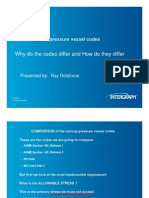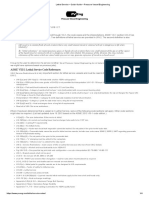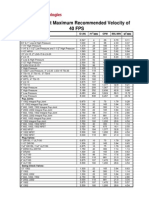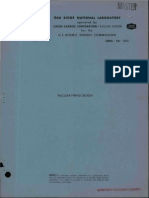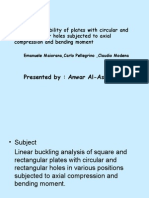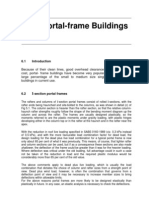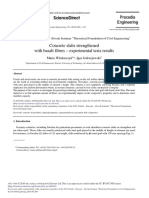Asme Viii Div.2
Asme Viii Div.2
Uploaded by
rps1977Copyright:
Available Formats
Asme Viii Div.2
Asme Viii Div.2
Uploaded by
rps1977Copyright
Available Formats
Share this document
Did you find this document useful?
Is this content inappropriate?
Copyright:
Available Formats
Asme Viii Div.2
Asme Viii Div.2
Uploaded by
rps1977Copyright:
Available Formats
CHAPTER
8
ANALYSIS
OF
COMPONENTS IN VIII-2
8.1 INTRODUCTION
Section VIII-2 requires stress analysis of vessel components when explicit design formulas are not given. This includes ued-in heads, head-to-shell junctions, expansion joints, thermal stresses, and stresses in components due to loads other than pressure. In performing the stress evaluation, the designer must determine the maximum stress at a given point or location. When computer programs such as ANSYS and NASTRAN are used to determine the stress, the output usually consists of the total combined stress at a given point. This stress must then be separated into its components of membrane, bending, and peak stresses. This is necessary in order to compare each of these components to a corresponding allowable stress given in VIII-2 or to properly establish an allowable fatigue life. In this chapter only stress categories, stress concentrations, combinations of stresses, and fatigue evaluation are discussed in accordance with the denitions and requirements of VIII-2.
8.2 STRESS CATEGORIES
Stress in any component and location is classied by VIII-2 as one of three categoriesprimary, secondary, and peak stresses. Primary stress, such as hoop stress in a cylinder due to internal pressure, is developed by the imposed loading and is necessary to satisfy the laws of equilibrium. It is not self-limiting in that gross distortion or failure of the structure will occur if its value substantially exceeds the yield stress. This primary stress is divided into two subcategories in VIII-2. They are primary membrane and primary bending stresses. The longitudinal and circumferential stresses in a cylinder due to internal pressure are classied as primary membrane stress. The primary membrane stress is again subdivided into two categories in VIII-2. They are referred to as general primary membrane and local primary membrane stresses. Examples of these primary stresses are given in Table 8.1. Primary bending stress in VIII-2 refers to such items as the bending of a at cover or a dished head due to internal pressure. Secondary stress is developed when the deformation of a component due to applied loads is restrained by other components. Secondary stress is self-limiting in that local yielding can redistribute the stress to a tolerable magnitude without causing failure. An example of secondary stress is the bending stress that develops at the attachment of a body ange to the shell. This attachment is referred to as a gross structural discontinuity. Other examples of gross structural discontinuity are given in Table 8.2. Another example of secondary stress is certain thermal stresses. These are referred to as general thermal stress. A typical example of this stress is the longitudinal bending stress that occurs along a vessel skirt due to temperature gradients along the length of the skirt. Other examples of general thermal stress are given in Table 8.3.
233
Downloaded From: http://asmedigitalcollection.asme.org/ on 03/24/2013 Terms of Use: http://asme.org/terms
234
Chapter 8
TABLE 8.1 PRIMARY STRESS CATEGORY
The third category of stress dened in VIII-2 is peak stress. Peak stress is so local that it does not cause any noticeable distortion in a component, but it may cause fatigue cracks or brittle fracture. Examples of peak stress are notch concentrations; local hot spots; local structural discontinuity, as dened in Table 8.2; and local thermal stress, as dened in Table 8.3 VIII-2 establishes limits for the three stress categories discussed so far. These limits are given in Table 8.4. The rationale for these limits are given in various publications (see such references as ASME, 1968; ASME, 1969; and Jawad and Farr, 1989). VIII-2 also lists the stress categories for some commonly encountered loading conditions and vessel components. These are given in Table 8.5. Example 8.1 Problem A cylindrical shell with a at cover, see Fig. E8.1, is subjected to an internal design pressure of 800 psi and an internal operating pressure of 700 psi. The allowable stress intensity value for the material from II-D is 20 ksi. What stress intensity values should be calculated at sections aa and bb, and what are the allowable stress intensities at these locations? Solution Section aa From Table 8.5, at heads develop general primary membrane stress, Pm, and primary bending stress, Pb, at the central region due to the internal design pressure of 800 psi. From Table 8.4 the allowable general primary membrane stress intensity, Pm, is equal to Sm (20 ksi). The allowable primary bending stress intensity, Pb, is equal to 1.5Sm (30 ksi).
Downloaded From: http://asmedigitalcollection.asme.org/ on 03/24/2013 Terms of Use: http://asme.org/terms
Analysis of Components in VIII-2
235
TABLE 8.2 STRUCTURAL DISCONTINUITY
TABLE 8.3 THERMAL STRESS
Downloaded From: http://asmedigitalcollection.asme.org/ on 03/24/2013 Terms of Use: http://asme.org/terms
236
Chapter 8
TABLE 8.4 STRESS CATEGORIES AND THEIR LIMITS (ASME VIII-2)
Section bb From Table 8.5, at heads develop local primary membrane stress, PL, and secondary stress, Q, at the junction with the shell due to internal pressure. From Table 8.4 the allowable local primary membrane stress, PL, due to the design pressure of 800 psi is equal to 1.5Sm (30 ksi). The total allowable stress due to local pri-
Downloaded From: http://asmedigitalcollection.asme.org/ on 03/24/2013 Terms of Use: http://asme.org/terms
Analysis of Components in VIII-2
237
TABLE 8.5 CLASSIFICATION OF STRESSES (ASME VIII-2)
NOTES: (1) Consideration must also be given to the possibility of wrinkling and excessive deformation in vessels with large diameter-to-thickness ratio. (2) If the bending moment at edge is required to maintain the bending stress in the center region within acceptable limits, the edge bending is classied as Pb; otherwise, it is classied as Q. (3) Consider possibility of thermal stress ratchet. (4) Equivalent linear stress is dened as the linear stress distribution which has the same net bending moment as the actual stress distribution.
mary membrane plus secondary stresses (PL + Q) is equal to 3Sm (60 ksi). It should be noted that the two stress values, PL + Q, must be calculated at the operating pressure of 700 psi rather than at the design pressure when comparing them to 3Sm, as shown in Table 8.4.
Downloaded From: http://asmedigitalcollection.asme.org/ on 03/24/2013 Terms of Use: http://asme.org/terms
238
Chapter 8
TABLE 8.5 (CONTD)
FIG. E8.1
Downloaded From: http://asmedigitalcollection.asme.org/ on 03/24/2013 Terms of Use: http://asme.org/terms
Analysis of Components in VIII-2
239
TABLE 8.6 SOME STRESS CONCENTRATION FACTORS USED IN FATIGUE Location
Fillet welds Nozzle in spherical segment Nozzle in cylindrical segment Tangential nozzle in cylinder Backing strips Bolts Cracklike defect
Stress Concentration
4.0 2.2 3.3 5.5 2.0 membrane 2.5 bending 4.0 5.0
VIII-2 Paragraph
5112 4612 4612 4614 AD412.1 5122 5111
8.3 STRESS CONCENTRATION
The stress concentration at a given location must be included in the stress analysis in order to establish the fatigue life of that component. VIII-2 lists a few stress concentration factors for llet welds and nozzle penetrations due to internal pressure, as shown in Table 8.6. All other stress concentration factors are usually obtained from handbooks such as Peterson (Peterson, 1974), experimental data, or a detailed stress evaluation using nite element analysis. It must be remembered that substantial inaccuracies could occur in using the nite element analysis if a large mesh is used near a stress concentration. The designer must exercise great judgment in establishing the correct mesh size near such concentrations in order to obtain accurate results. Example 8.2 Problem Categorize the stresses at section b-b in Example 8.1 if a stress concentration factor (SCF) of 4.0 is used at that location due to weld details. Solution Section bb From Example 8.1, at heads develop PL and Q at the junction with the shell due to internal pressure. Similarly, PL due to design pressure is equal to 1.5Sm (30 ksi). The quantity PL + Q due to operating pressure is equal to 3Sm (60 ksi). Also, from Table 8.4, the quantity (SCF)(PL + Q) at the operating pressure of 700 psi must be used to nd the quantity Sa in determining the fatigue life of this section.
8.4 COMBINATIONS OF STRESSES
In order to compare the actual stress at a given location to the allowable stress in VIII-2, the designer must categorize the calculated stress as primary, secondary, or peak. The designer must then combine the categories in the appropriate fashion in order to compare them to the allowable stresses given in Table 8.4. Identifying the stress category may be difcult sometimes, since the output of many nite element calculations are programmed to display only the principal, or effective, stress at a location. Thus, the designer has to either instruct the program to itemize the stresses or manually separate them into various categories. Separating the stress output from a nite element (FE) program into its components is called linearization. A typical computer output may look like the solid line shown in Fig. 8.1. The FE line must be divided into a membrane stress and bending stress as shown. These values can then be compared to the allowable stress given in Table 8.4. A typical output of a detailed stress analysis consists of three normal stresses, r, l, h, and three shearing stresses rl, rh, lh. From these six stresses, the designer can obtain three principal stresses 1, 2, 3, by using the classical equation
Downloaded From: http://asmedigitalcollection.asme.org/ on 03/24/2013 Terms of Use: http://asme.org/terms
240
Chapter 8
FIG. 8.1
LINEARIZING STRESS DISTRIBUTION
maxmin = (i + j)/2 [(i j)2/4 + 2ij]1/2
(8.1)
The maximum stress intensity dened in VIII-2 is the absolute value of the larger of the following values
S12 = 1 2 S13 = 1 3 S23 = 2 3
The maximum stress intensity is compared with allowable values in Table 8.4. Example 8.3 Problem The forces and bending moments in sections aa and bb due to design pressure in Example 8.1 were calculated from the classical theory of plates and shells as Section aa Membrane force in the radial direction = 2602.3 Ib Membrane force in the hoop direction = 0.0 Bending moment in the radial direction = 89,052.0 in.-lb Bending moment in the hoop direction = 89,052.0 in.-lb
Downloaded From: http://asmedigitalcollection.asme.org/ on 03/24/2013 Terms of Use: http://asme.org/terms
Analysis of Components in VIII-2
241
Section bb Bending moment in the axial direction = 5988.0 in.-lb Bending moment in the tangential direction = 1796.4 in.-lb Shearing force in the radial direction = 2602.3 lb Membrane force in the axial direction = 9600 lb Membrane force in the hoop direction = 0 (assuming the shell cannot grow radially at this location. A more accurate solution of this problem can be obtained by taking into consideration the inward deection of point b-b due to the edge rotation. The value of this deection can be taken as the edge rotation times half the at cover thickness.) Determine the stress values at sections a-a and b-b in accordance with the VIII-2 procedures and compare them with the allowable stresses. Solution Section aa The membrane stress is
Pm = force/t = 2602.3/6.375 = 410 psi
The bending stress is
Pb = 6M/t2 = 6 89052/6.3752 = 13,150 psi
From Table 8.4,
Allowable Pm = 20,000 psi > 410 psi Allowable Pm + Pb = 30,000 psi > 13,560 psi (13150 + 410)
Section bb The axial membrane stress at design pressure is
Pm = force/t = 9600/1.0 = 9600 psi
The axial membrane stress at operating pressure is
Pm = (operating P/design P)(force/t) = (700/800)(9600/1.0) = 8400 psi
The axial bending stress at operating pressure is
Q = (operating P/design P)(6M/t2) = (700/800)(6 5988.0/1.02) = 31,440 psi
From Table 8.4,
Allowable Pm = 20,000 psi > 9600 psi Allowable Pm + Q = 60,000 psi > 39,840 psi (8400 + 31,440)
Downloaded From: http://asmedigitalcollection.asme.org/ on 03/24/2013 Terms of Use: http://asme.org/terms
242
Chapter 8
The hoop membrane stress at design pressure is
Pm = force/t = 0/1.0 = 0 psi
The hoop membrane stress at operating pressure is
Pm = (operating P/design P)(force/t) = (700/800)(0/1.0) = 0 psi
The hoop bending stress at operating pressure is
Q = (operating P/design P)(6M/t2) = (700/800)(6 1796.4/1.02) = 9430 psi
From Table 8.4,
Allowable Pm = 20,000 psi > 0 psi Allowable Pm + Q = 60,000 psi > 9430 psi (9430 + 0)
Example 8.4 Problem A nite element (FE) analysis was performed on a at head-to-shell junction, shown in Fig. E8.4. Three different loading conditions were calculated. They were pressure, mechanical, and thermal loading. The results of the FE stress output are shown in Table E8.4. Assume the operating and design pressures are the same and all initial stress values are equal to zero. Assume the allowable stress value to be 14 ksi. Calculate the primary membrane stress and the secondary stress at the junction. Solution Primary Membrane Stress Table 8.4 indicates that primary membrane stress is produced by mechanical loads only. Thus, in Table E8.4 under the Membrane Stress part, only the pressure, mechanical, or a combination of pressure and mechanical are to be used. Thermal stresses are ignored in this case. The FE results indicate that there is a shearing stress in the r,l plane. Thus the two principal stresses, 1 and 2, in this plane are calculated from Eq. (8.1), while the third principal stress is h. The three principal stresses become 1
Pressure, psi Mechanical, psi Pressure plus mechanical, psi 6200 1370 7230
2
900 30 530
h
11,400 500 11,900
And the maximum stress intensity values are given by Maximum Stress Intensity, psi
Pressure Mechanical Pressure plus mechanical 12,300 1340 12,430
Allowable Pm = 14,000 psi > 12,430 psi
Downloaded From: http://asmedigitalcollection.asme.org/ on 03/24/2013 Terms of Use: http://asme.org/terms
Analysis of Components in VIII-2
243
FIG. E8.4 MODEL OF A FINITE ELEMENT LAYOUT IN A FLAT HEAD-TO-SHELL JUNCTION
Secondary Stress Table 8.4 indicates that secondary stress is produced by mechanical and thermal loads. The FE results indicate that there is a shearing stress in the r,l plane. Thus the two principal stresses, 1 and 2, in this plane are calculated from Eq. (8.1), while the third principal stress is h. The three principal stresses become 1
Pressure, psi Mechanical, psi Pressure plus mechanical, psi Pressure plus mechanical plus thermal, psi 2100 1760 3650 12,920
2
540 140 1650 1520
h
11,000 700 10,300 14,000
And the maximum stress intensity values are given by Maximum Stress Intensity, psi
Pressure Mechanical Pressure plus mechanical Pressure plus mechanical plus thermal 11,540 2460 11,950 15,520
Allowable Pm + Q = 42,000 psi > 15,520
Downloaded From: http://asmedigitalcollection.asme.org/ on 03/24/2013 Terms of Use: http://asme.org/terms
244
Chapter 8
TABLE E8.4 SUMMARY OF FINITE ELEMENT OUTPUT
8.5 FATIGUE EVALUATION
When a fatigue evaluation is required in accordance with AD-160 of VIII-2 or by the user or a qualied engineer, it shall be performed in accordance with the requirements of Appendix 5 of VIII-2. The number of cycles are evaluated from fatigue charts such as the one shown in Fig. 8.2 for carbon steel. In most applications the process cycle is easily determined. Each cycle consists of a start-up condition in pressure and temperature, a steady state, and then shutdown of pressure and temperature. This is illustrated in Fig. 8.3a. More complex cycles often occur where there is reversal of stress, as shown in Fig. 8.3b. On occasion, complicated cycles occur, such as the one shown in Fig. 8.3c. For each cycle the designer determines the maximum stress range, which is the algebraic difference between the maximum and minimum stress intensities in a cycle. The alternating stress, which is half the maximum stress range, is then obtained. With this value, the fatigue chart is then used to obtain the number of permissible cycles for each stress range. A Cumulative Usage Factor is then determined for each type of cycle considered by the designer.
Downloaded From: http://asmedigitalcollection.asme.org/ on 03/24/2013 Terms of Use: http://asme.org/terms
Analysis of Components in VIII-2
245
Downloaded From: http://asmedigitalcollection.asme.org/ on 03/24/2013 Terms of Use: http://asme.org/terms
FIG. 8.2 FATIGUE CURVES FOR CARBON, LOW ALLOY, 4XX, HIGH ALLOY, AND HIGH STRENGTH STEELS FOR TEMPERATURES NOT EXCEEDING 700F (ASME VIII-2)
246
Chapter 8
FIG. 8.3 CYCLIC CURVES
Example 8.5 Problem Use the Peak stress values given in Example 8.4 to determine the fatigue life at the location indicated in Fig. E8.4. Use Fig. 8.2 for a fatigue chart. Solution Table 8.4 indicates that the peak stress must be combined with the membrane and bending stresses to determine fatigue life.
Downloaded From: http://asmedigitalcollection.asme.org/ on 03/24/2013 Terms of Use: http://asme.org/terms
Analysis of Components in VIII-2
247
Peak Plus Secondary Stress From Table E8.4, we combine the peak stresses for pressure, mechanical, and thermal conditions with those of membrane plus bending stresses. This gives peak plus membrane plus bending stress, as shown below: r
Pressure, psi Mechanical, psi Pressure plus mechanical, psi Pressure plus mechanical plus thermal, psi 2000 1250 750 950
l
2000 3900 5900 7900
h
11,000 1950 9050 10950
rl
200 1950 1750 1050
The three principal stresses become 1
Pressure, psi Mechanical, psi Pressure plus mechanical, psi Pressure plus mechanical plus thermal, psi 2010 4930 6400 8020
+2
2010 220 280 1070
h
11,000 1950 9050 10,950
And the maximum stress intensity values are given by Maximum Stress Intensity, psi
Pressure Mechanical Pressure plus mechanical Pressure plus mechanical plus thermal 13,010 6880 9330 12,020
The maximum alternating stress is
Sa = 13010/2 = 6500 psi
From Fig. 8.2, with Sa equal to 6500 psi, the maximum number of cycles is > 1,000,000.
Downloaded From: http://asmedigitalcollection.asme.org/ on 03/24/2013 Terms of Use: http://asme.org/terms
Downloaded From: http://asmedigitalcollection.asme.org/ on 03/24/2013 Terms of Use: http://asme.org/terms
You might also like
- Technical Writing A-Z: A Commonsense Guide to Engineering Reports and Theses, Second Edition, British English: A Commonsense Guide to Engineering Reports and Theses, U.S. English Second EditionFrom EverandTechnical Writing A-Z: A Commonsense Guide to Engineering Reports and Theses, Second Edition, British English: A Commonsense Guide to Engineering Reports and Theses, U.S. English Second EditionNo ratings yet
- Dennis R Moss 4th EditionDocument5 pagesDennis R Moss 4th Editionsenthil kumarNo ratings yet
- Using The ASME VIII-1 Nozzle F Factor (UG-37)Document7 pagesUsing The ASME VIII-1 Nozzle F Factor (UG-37)Ricardo Paz Soldan100% (1)
- Modeling of Internal Pressure and Thrust Load On Nozzles Using WRC 368Document5 pagesModeling of Internal Pressure and Thrust Load On Nozzles Using WRC 368m5416No ratings yet
- Effective Bearing Length of Crane Mats PDFDocument8 pagesEffective Bearing Length of Crane Mats PDFOktay100% (1)
- AU Design GuideDocument74 pagesAU Design GuideShin JoonHoNo ratings yet
- Fatigue Analysis of 6300 Liters Pressure Vessel by Using Cyclic ServiceDocument7 pagesFatigue Analysis of 6300 Liters Pressure Vessel by Using Cyclic ServiceFisul RahumanNo ratings yet
- Probabilistic Physics of Failure Approach to Reliability: Modeling, Accelerated Testing, Prognosis and Reliability AssessmentFrom EverandProbabilistic Physics of Failure Approach to Reliability: Modeling, Accelerated Testing, Prognosis and Reliability AssessmentNo ratings yet
- PV Elite Adding A MaterialDocument11 pagesPV Elite Adding A Material9913489806No ratings yet
- PV Elite WebinarDocument24 pagesPV Elite WebinarAndrea Hank LattanzioNo ratings yet
- 16 Preiss Study en 13445 Asme ViiiDocument26 pages16 Preiss Study en 13445 Asme ViiiDubaiHMARNo ratings yet
- Maximum Allowable Stress: Mechanical Design of Pressure VesselsDocument17 pagesMaximum Allowable Stress: Mechanical Design of Pressure Vesselsfauzi100% (2)
- 3D Stress CriteriaDocument5 pages3D Stress CriteriaFernando Diez100% (1)
- Pressure Vessel Design Training - Course ContentDocument13 pagesPressure Vessel Design Training - Course Contentamol shinde100% (1)
- PV Elite ResultDocument18 pagesPV Elite ResultVeny MartianiNo ratings yet
- Stress ClassesDocument9 pagesStress ClassesRushiraj JaiswalNo ratings yet
- Conversion ASME Unit ConversionDocument3 pagesConversion ASME Unit ConversionMohdBadruddinKarimNo ratings yet
- Stress Analysis of Pressure Vessel Nozzle Using Fea IJERTCONV6IS16004Document6 pagesStress Analysis of Pressure Vessel Nozzle Using Fea IJERTCONV6IS16004Kingston RivingtonNo ratings yet
- Multi Layer Pressure VesselsDocument8 pagesMulti Layer Pressure VesselsprivatehomeNo ratings yet
- ASME - 2286-1 Alternative Rules For Determining Allowable External PressureDocument16 pagesASME - 2286-1 Alternative Rules For Determining Allowable External PressureMike Dukas100% (1)
- 7-12-0008 Rev6 (Lug Support For Vertical Vessel) PDFDocument1 page7-12-0008 Rev6 (Lug Support For Vertical Vessel) PDFsumit kumarNo ratings yet
- ASME Section VIII-Division 1 - Pressure Vessels - CASTI GuidebookDocument1 pageASME Section VIII-Division 1 - Pressure Vessels - CASTI GuidebookcristinelbNo ratings yet
- Lethal Service - Quick Guide - Pressure Vessel EngineeringDocument4 pagesLethal Service - Quick Guide - Pressure Vessel EngineeringVilas Andhale100% (1)
- WRC Load AnalysisDocument5 pagesWRC Load Analysisyogacruise100% (1)
- Combined Stress Caclulation - PveliteDocument2 pagesCombined Stress Caclulation - Pveliterajeshvyas_510% (1)
- PV Elite (Construccion de Recipiente) MDMTDocument8 pagesPV Elite (Construccion de Recipiente) MDMTAlejandro CanoNo ratings yet
- Sa-516 70 TDCDocument2 pagesSa-516 70 TDCshazan100% (1)
- Pressure Vessel Design CalcDocument48 pagesPressure Vessel Design CalcSyed Zain AliNo ratings yet
- Design of Cylindrical Shell Part 2Document14 pagesDesign of Cylindrical Shell Part 2Tito FebriantoNo ratings yet
- 7-12-0024 Rev 7Document1 page7-12-0024 Rev 7cynideNo ratings yet
- PV EliteDocument680 pagesPV Elitengocanh_songlongNo ratings yet
- Comparative Study EN 13445 / ASME Section VIII Div. 1 & 2Document48 pagesComparative Study EN 13445 / ASME Section VIII Div. 1 & 2Anand PatelNo ratings yet
- DESIGN OF PRESSURE VESSEL Full Report DEDocument48 pagesDESIGN OF PRESSURE VESSEL Full Report DELuis Muñoz100% (2)
- BN-DS-T29 Collar Bolts For Removable Bundle Heat ExchangerDocument1 pageBN-DS-T29 Collar Bolts For Removable Bundle Heat ExchangerAlexDdd123No ratings yet
- Calcu Nozzle NeckDocument15 pagesCalcu Nozzle Necksachmaya50% (2)
- ASME DIV 2 Class 1 Vs Class 2Document3 pagesASME DIV 2 Class 1 Vs Class 2Idris SiddiquiNo ratings yet
- Pressure Vessel FormulaDocument9 pagesPressure Vessel FormulaNasir Khan JadoonNo ratings yet
- Fixed Tubesheet Design ConditionDocument1 pageFixed Tubesheet Design ConditionPratik ThakkarNo ratings yet
- Nozzle Calculations: Understanding Asme Code Calculations-Pressure VesselsDocument28 pagesNozzle Calculations: Understanding Asme Code Calculations-Pressure VesselsRamakrishnan SrinivasanNo ratings yet
- Code Case 2901 Nozzle S1 SL No Description Unit Value: Provided Nozzle Flange Is Safe For External LoadingsDocument1 pageCode Case 2901 Nozzle S1 SL No Description Unit Value: Provided Nozzle Flange Is Safe For External LoadingsguravdrNo ratings yet
- Design of Large Opening Nozzle by Bulletin WRC-107Document12 pagesDesign of Large Opening Nozzle by Bulletin WRC-107ALONSO GOMEZNo ratings yet
- Load Case Explanation in PV EliteDocument2 pagesLoad Case Explanation in PV ElitekuselanmlNo ratings yet
- WRC 107 TipsDocument4 pagesWRC 107 Tipsyatin888No ratings yet
- Asme Viii Uhx Tubesheet CalcsDocument3 pagesAsme Viii Uhx Tubesheet CalcsjdfdfererNo ratings yet
- Code Case 2901 - Consideration of External Loads On ASME B16.5 Standard Flanges Under ASME Code Section VIII, Division 1 & 2Document2 pagesCode Case 2901 - Consideration of External Loads On ASME B16.5 Standard Flanges Under ASME Code Section VIII, Division 1 & 2msn1981No ratings yet
- External Pressure - Pressure Vessel EngineeringDocument15 pagesExternal Pressure - Pressure Vessel Engineeringarjun100% (1)
- Design Analysis of PVDocument114 pagesDesign Analysis of PVDivakar Panigrahi100% (8)
- Bolted Flanged Joint: Flanges, Studs & Gaskets. Recommended Practices for the Assembly of a Bolted Flange Joint.From EverandBolted Flanged Joint: Flanges, Studs & Gaskets. Recommended Practices for the Assembly of a Bolted Flange Joint.No ratings yet
- Asme Viii Div.2 PDFDocument16 pagesAsme Viii Div.2 PDFRicardo Paz SoldanNo ratings yet
- PDF Asme VIII Div2 DDDocument7 pagesPDF Asme VIII Div2 DDCalcgen EngineeringNo ratings yet
- Elastic Stress Analysis For Heat Exchanger Channel Head For Protection Against Plastic Collapse and Protection Against Local Failure (FEA)Document8 pagesElastic Stress Analysis For Heat Exchanger Channel Head For Protection Against Plastic Collapse and Protection Against Local Failure (FEA)kingstonNo ratings yet
- Stresses Considered in Fatigue Analysis 1995Document10 pagesStresses Considered in Fatigue Analysis 1995Abid HasanNo ratings yet
- Journal IssueDocument5 pagesJournal IssueHernâniCruzNo ratings yet
- Me 42 PDFDocument5 pagesMe 42 PDFMohamed Rafeek0% (1)
- Design by Rule-Design by Analysis PDFDocument18 pagesDesign by Rule-Design by Analysis PDFChandra ClarkNo ratings yet
- Pressure Vessel Report564Document84 pagesPressure Vessel Report564Anonymous GlYbhtWNo ratings yet
- 2 Research Review: Piping and Pressure Vessel Standards and Codes (3) - They Have Compiled Their Findings inDocument24 pages2 Research Review: Piping and Pressure Vessel Standards and Codes (3) - They Have Compiled Their Findings inIman SatriaNo ratings yet
- Stress Types: Common Load Types and CategoriesDocument8 pagesStress Types: Common Load Types and CategoriesbahmanNo ratings yet
- Analysis of Stress in Nozzle/Shell of Cylindrical Pressure Vessel Under Internal Pressure and External Loads in NozzleDocument8 pagesAnalysis of Stress in Nozzle/Shell of Cylindrical Pressure Vessel Under Internal Pressure and External Loads in NozzleGaurav BedseNo ratings yet
- N59018491 PDFDocument8 pagesN59018491 PDFsenthilkumarNo ratings yet
- Chapter b04 Stress Analysis of Piping System PDFDocument108 pagesChapter b04 Stress Analysis of Piping System PDFrogel_ganaNo ratings yet
- Fatigue Analysis Using CAESAR IIDocument7 pagesFatigue Analysis Using CAESAR IIayounga100% (1)
- A Fresh Approach To Gas Lift, Alan Brodie PTCDocument15 pagesA Fresh Approach To Gas Lift, Alan Brodie PTCrps1977No ratings yet
- High Pressure HIP AccessoriesDocument29 pagesHigh Pressure HIP Accessoriesrps1977No ratings yet
- Low TemperaturePropertiesofNickelAlloySteels 1238Document36 pagesLow TemperaturePropertiesofNickelAlloySteels 1238Toan Nguyen ThienNo ratings yet
- Corrosion ControlDocument306 pagesCorrosion Controlrps1977100% (6)
- CODE DIV - 2 Review of The ASME Code Section VIII Division 2 - 2007 PDFDocument12 pagesCODE DIV - 2 Review of The ASME Code Section VIII Division 2 - 2007 PDFManish542100% (1)
- Bomba Reda d1400nDocument6 pagesBomba Reda d1400nrps1977100% (1)
- Corrosion ControlDocument306 pagesCorrosion Controlrps1977100% (6)
- Du Pont Product SelectorDocument3 pagesDu Pont Product Selectorrps1977No ratings yet
- Flow Rates at Maximum Recommended Velocity of 40 FPS: Size and Model Id (In) FT /min GPM Bbl/Min M /min Swivel JointsDocument1 pageFlow Rates at Maximum Recommended Velocity of 40 FPS: Size and Model Id (In) FT /min GPM Bbl/Min M /min Swivel Jointsrps1977No ratings yet
- Wellhead Design SlideshowDocument38 pagesWellhead Design Slideshowrps1977100% (5)
- Size: 11.750 In. Wall: 0.489 In. Weight: 60.00 LBS/FT Grade: P110 Min. Wall Thickness: 87.5 %Document1 pageSize: 11.750 In. Wall: 0.489 In. Weight: 60.00 LBS/FT Grade: P110 Min. Wall Thickness: 87.5 %rps1977No ratings yet
- Design of Flange JointDocument14 pagesDesign of Flange Jointmichal_lysy100% (2)
- 5 Api 6aDocument8 pages5 Api 6arps1977100% (2)
- Interpretation of Finite Element Stresses According To ASME Section IIIDocument13 pagesInterpretation of Finite Element Stresses According To ASME Section IIIrps1977100% (2)
- RP-002393 Cab Comp Integral CameronDocument43 pagesRP-002393 Cab Comp Integral Cameronrps197775% (4)
- Nuclear Piping DesignDocument218 pagesNuclear Piping DesignLuis OrtizNo ratings yet
- Structural Analysis and Design: STAAD - Pro Steel Design (FAQ)Document19 pagesStructural Analysis and Design: STAAD - Pro Steel Design (FAQ)Suhas NatuNo ratings yet
- Practice Problems For Finite Element Method: April 2019Document48 pagesPractice Problems For Finite Element Method: April 2019emreNo ratings yet
- Cep MosDocument27 pagesCep MosHuzi MalixNo ratings yet
- Prefabricated BuildingsDocument8 pagesPrefabricated BuildingsJudelle GumallaoiNo ratings yet
- Department of Mechanical Engineering Machine Design Objective QuestionDocument211 pagesDepartment of Mechanical Engineering Machine Design Objective QuestionSushant TiwariNo ratings yet
- Everything You Need To Know About Flatteners and Levelers For Coil Processing-Part 2 - The FabricatorDocument7 pagesEverything You Need To Know About Flatteners and Levelers For Coil Processing-Part 2 - The FabricatorSIMONENo ratings yet
- Canam Steel Deck PDFDocument168 pagesCanam Steel Deck PDFAnonymous 8hx6hKN3No ratings yet
- Elastic Stability of Plates With Circular and Rectangular Holes Subjected To Axial Compression and Bending MomentDocument39 pagesElastic Stability of Plates With Circular and Rectangular Holes Subjected To Axial Compression and Bending Momenthunter111No ratings yet
- Bending of BeamsDocument17 pagesBending of Beamskusangichandana100% (1)
- Continuous BeamsDocument5 pagesContinuous Beamsbulealiyi71No ratings yet
- Steel Design Example I.7Document14 pagesSteel Design Example I.7edwardNo ratings yet
- CH 5 - Beams and Frames - Part 2Document25 pagesCH 5 - Beams and Frames - Part 2Fawzia HassanNo ratings yet
- Essential of Structural System For Seismic Resistance: Seismic Design of Structures by Dr. M. Burhan SharifDocument68 pagesEssential of Structural System For Seismic Resistance: Seismic Design of Structures by Dr. M. Burhan SharifAbdullahNo ratings yet
- UNIT-II - (Part-2-A) RECTANGULAR TANK - APPROX METHODDocument88 pagesUNIT-II - (Part-2-A) RECTANGULAR TANK - APPROX METHODDuraid FalihNo ratings yet
- Effect of Temperature Variation and Shrinkage On Circular TanksDocument12 pagesEffect of Temperature Variation and Shrinkage On Circular TanksGelbert SilotNo ratings yet
- 10 1016@j Istruc 2019 02 018Document10 pages10 1016@j Istruc 2019 02 018shak543No ratings yet
- Economics For Structural Steel Portal FramesDocument11 pagesEconomics For Structural Steel Portal Framesthomas kilian100% (1)
- General: Title Design of Corbel Cl. No. Design Calculations ReferencesDocument15 pagesGeneral: Title Design of Corbel Cl. No. Design Calculations ReferencesGovendan GopalakrishnanNo ratings yet
- Wisdom:: WeldingDocument5 pagesWisdom:: WeldingSathish KumarNo ratings yet
- Diaphragm ActionsDocument6 pagesDiaphragm ActionskamakshiNo ratings yet
- "Monorail" - Monorail Beam Analysis: Program DescriptionDocument14 pages"Monorail" - Monorail Beam Analysis: Program DescriptionYash SutharNo ratings yet
- Dynamic Soil-Structure Interaction Analysis Using Ls-Dyna: Dr. Navin Peiris Ove Arup & Partners, LondonDocument2 pagesDynamic Soil-Structure Interaction Analysis Using Ls-Dyna: Dr. Navin Peiris Ove Arup & Partners, LondonAnonymous v1blzDsEWANo ratings yet
- Application Examples Manual (Bridge, Civil and Structural)Document520 pagesApplication Examples Manual (Bridge, Civil and Structural)DineshKMPNo ratings yet
- Use of Steel Fibre in m20 ConcreteDocument44 pagesUse of Steel Fibre in m20 ConcretenemsharuNo ratings yet
- Concrete Slabs Strengthened With Basalt Fibres - Experimental Tests ResultsDocument8 pagesConcrete Slabs Strengthened With Basalt Fibres - Experimental Tests ResultsBanNo ratings yet
- Policarpio 5 - Refresher SECDocument2 pagesPolicarpio 5 - Refresher SECMigaea100% (1)
- Chapter 7 - Structural AnalysisDocument34 pagesChapter 7 - Structural AnalysisDenice Castro100% (1)









